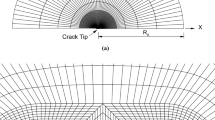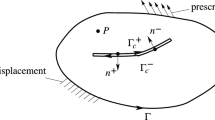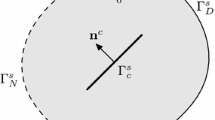Abstract
This paper presents a numerical method to model a general system containing cracks and voids in an infinite elastic plate under remote cyclic loads. By extending Bueckner’s principle suited for a crack to a general system containing cracks and voids, the original problem is divided into a homogeneous problem (the one without cracks and voids) subjected to remote loads and a void-crack problem in an unloaded body with applied tractions on the surfaces of cracks and voids. Thus, the results in terms of the stress intensity factors can be calculated by considering the latter problem, which is analyzed easily by using the hybrid displacement discontinuity method (a boundary element method). Further, a fatigue growth technique of a mixed-mode crack is combined with the numerical approach to simulating a void–crack interaction problem under cyclic loads. Test examples are included to illustrate that the numerical method is very simple and effective for analyzing a void–crack interaction problem.
Similar content being viewed by others
References
Evans A.G., Faber K.T.: Toughening of ceramics by circumferential microcracking. J. Am. Ceram. Soc. 64(7), 394–398 (1981)
Hutchinson J.W.: Crack tip shielding by micro-cracking in brittle solids. Acta Metall. 35, 1605–1619 (1987)
Charalambides P., McMeeking R.M.: Finite element method simulation of crack propagation in a brittle microcracking solids. Mech. Mater. 6, 71–87 (1987)
Chudnovsky A., Kachanov M.: Interaction of a crack with a field of microcracks. Int. J. Eng. Sci. 21, 1009–1018 (1983)
Chudnovsky A., Dolgopolsky A., Kachanov M.: Elastic interaction of a crack with a microcrack array. Int. J. Solids Struct. 23, 1–21 (1987)
Kachanov M., Montagut E.: Interaction of a crack certain microcrack array. Eng. Fract. Mech. 25, 625–636 (1986)
Horii H., Nemat-Nasser S.: Elastic fields of interacting inhomogeneities. Int. J. Solids Struct. 21, 731–745 (1985)
Hori M., Nemat-Nasser S.: Interacting microcracksnear the tip in the process zone of a macrocrack. J. Mech. Phys. Solids 35(5), 601–629 (1987)
Gong S.X., Horii H.: General solution to the problem of microcracks near the tip of a main crack. J. Mech. Phys. Solids 37, 27–46 (1989)
Rose L.R.F.: Microcrack interaction with a main crack. Int. J. Fract. 31, 233–242 (1986)
Rubinstein A.: Macrocrack interaction with semi-infinite microcrack array. Int. J. Fract. 27, 113–119 (1985)
Rubinstein A.: Macrocrack–microdefect interaction. ASME J. Appl. Mech. 53, 503–510 (1986)
Shum D.K.M., Hutchinson J.W.: On toughening by microcracks. Mech. Mater. 9, 83–91 (1990)
Kachanov, M.: In: Hutchinson, J.W., Wu, T. (eds.) Advances in Applied Mechanics, vol. 30, pp. 259–445 (1993)
Gong S.X., Meguid S.A.: Microdefect interacting with a main crack: a general treatment. Int. J. Mech. Sci. 34, 933–945 (1992)
Hu K.X., Chandra A., Huang Y.: Multiple void-crack interaction. Int. J. Solids Struct. 30(11), 1473–1489 (1993)
Ducourthial E., Bouchaud E., Chaboche J.L.: Influence of microcracks on a propagation of macrocracks. Comput. Mater. Sci. 19, 229–234 (2000)
Buckner H.F.: The propagation of cracks and the energy of elastic deformation. ASME J. Appl. Mech. 80, 1225–1230 (1958)
Yan X.: An efficient and accurate numerical method of stress intensity factors calculation of a branched crack. ASME J. Appl. Mech. 72(3), 330–340 (2005)
Crouch S.L., Starfield A.M.: Boundary Element Method in Solid Mechanics, with Application in Rock Mechanics and Geological Mechanics, London. Geore Allon & Unwin, Bonton (1983)
Murakami Y.: Stress Intensity Factors Handbook. Pergamon Press, New York (1987)
Sih G.C., Barthelemy B.M.: Mixed mode fatigue crack growth prediction. Eng. Fract. Mech. 13, 439–451 (1980)
Bittencourt T.N., Wawrzynek P.A., Ingraffea A.R., Sousa J.L.: Quasi-automated simulation of crack propagation for 2D LEFM problems. Eng. Fract. Mech. 55, 321–334 (1996)
Yan X., Du S., Zhang Z.: Mixed-mode fatigue crack growth prediction in biaxially stretched sheets. Eng. Fract. Mech. 43(3), 471–475 (1992)
Erdogan F., Sih G.C.: On the crack extension in plates under plane loading and transverse shear. J. Basic Eng. 85, 519–527 (1963)
Author information
Authors and Affiliations
Corresponding author
Rights and permissions
About this article
Cite this article
Yan, X., Miao, C. A numerical method for a void–crack interaction under cyclic loads. Acta Mech 223, 1015–1029 (2012). https://doi.org/10.1007/s00707-011-0596-6
Received:
Revised:
Published:
Issue Date:
DOI: https://doi.org/10.1007/s00707-011-0596-6




